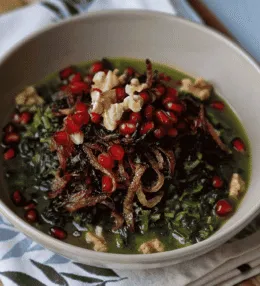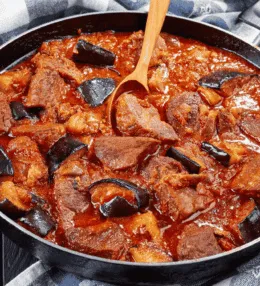
- View
Table of Contents
ToggleCumberland sausage carries a hearty spirit from the fells and market towns of Cumbria. It is a long coiled sausage served in thick spirals, cut into generous slices at the table. The seasoning leans into pepper, herbs, and a little spice, giving comfort that feels both rustic and honest.
Cooked slowly in a pan, the sausage browns deeply and holds its juices. It welcomes mashed potatoes, onion gravy, and garden peas, yet it is just as happy beside roast vegetables or a breakfast spread. The appeal lies in firm texture, lively seasoning, and a gentle savoury finish.
Travel through the region and you will find butchers who guard their mixes. Some prefer a bolder heat, others favour nutmeg and a soft herb note. What links them is pride in the coil, a shape that turns a simple supper into a centrepiece and invites easy sharing.
Want to dive deeper into British Cuisine? Don’t miss our post on Traditional British Foods to Try
What is a Cumberland sausage?
Cumberland sausage is a traditional pork sausage shaped into a large spiral and sold by weight. The meat is chopped rather than finely minced, which keeps the bite satisfyingly coarse. Natural casings are filled, the coil is tied, and the links are usually cooked as one piece.
The flavour profile leans on black pepper, thyme or sage, a touch of mace or nutmeg, and gentle warmth from white pepper. Some add breadcrumbs to carry juices, others go without for a meat forward slice. Either way, the character is robust yet balanced, made for slow cooking.
To serve, the coil can be pan fried or roasted. It benefits from a medium heat so the fat renders slowly and the herbs have time to bloom. A splash of cider in the pan creates quick gravy, while mustard brings a clean bite that lifts the richness.
Ingredients and Taste
Pork shoulder is the usual cut, chosen for flavour and steady fat content. Fresh or dried herbs such as thyme, sage, or marjoram provide a green edge. Ground spices like black and white pepper, mace, and nutmeg lend warmth. A little salt and sometimes rusk or breadcrumbs round things out.
Good examples taste peppery and aromatic, with a clean pork savouriness. The coarse chop gives chew, the fat melts and seasons each mouthful, and the herbs bring lift rather than perfume. When cooked patiently the casing snaps lightly, the inside stays moist, and the pan offers rich drippings.
The sausage stands up to bold partners. Think sharp mustard, cider braised onions, pickled red cabbage, or a dollop of apple sauce. In a stew it stays firm, in a bun it shines with fried onions, and on a breakfast plate it provides a sturdy anchor that never feels heavy.
A Taste of History
The name ties it to the historic county of Cumberland, now part of modern Cumbria. Local records from the nineteenth century mention a coiled sausage sold by length in markets and fairs. The style likely reflects practical needs, an easy way to portion and a grand look for traders stalls.
Trade once brought spices through Cumbrian ports, which helps explain the lively pepper and mace. Farms supplied pork, villages shared curing skills, and each butcher tuned the seasoning to local taste. Over time the sausage became a regional emblem, served for celebrations as well as weekday suppers.
Today protected geographical indication rules recognise Traditional Cumberland Sausage made in Cumbria with a defined meat content and a coarse cut. Supermarkets across Britain sell versions inspired by it, yet a visit to a Cumbrian butcher remains a treat, where the coil is cut fresh and cooked the same day.
How to Make Cumberland Sausage (Spiral Pork Sausage)
Cumberland sausage is a proud symbol of Northern England’s culinary tradition. Known for its coarse texture, bold peppery seasoning, and signature spiral shape, this sausage delivers a robust, rustic flavour. The preparation focuses on balance – seasoning well, mixing evenly, and keeping the meat cold for perfect texture. See the recipe card at the bottom for printable directions
Ingredients
- 1 kg pork shoulder, trimmed and finely minced (with about 20% fat)
- 100 ml cold water
- 1 tsp salt
- 1 tsp freshly ground black pepper
- ½ tsp white pepper
- 1 tsp dried sage
- ½ tsp ground nutmeg
- ½ tsp ground mace
- ½ tsp dried thyme
- ½ tsp ground coriander
- 1 tsp mustard powder
- 1 tsp brown sugar
- Natural pork casings, soaked and rinsed
Cooking Instructions
Step 1: Prepare the meat mixture
Trim the pork shoulder, removing excess sinew but keeping some fat for juiciness. Mince the meat using a coarse grinder plate to maintain a traditional texture. Keep the meat chilled to ensure a firm, easy to handle mixture.
Step 2: Mix the seasonings
In a small bowl, combine salt, both peppers, sage, nutmeg, mace, thyme, coriander, mustard powder, and brown sugar. Mixing these dry ingredients first helps distribute the flavours evenly throughout the sausage.
Step 3: Combine meat and seasoning
Place the minced pork in a large mixing bowl. Sprinkle over the seasoning blend and pour in the cold water. Using your hands, mix thoroughly for 3 to 5 minutes until the mixture becomes slightly sticky. This helps bind the sausage naturally without additives.
Step 4: Chill the mixture
Cover the bowl and refrigerate for at least 1 hour to allow the flavours to blend and the fat to firm up. This step ensures a well-balanced seasoning and helps the sausage retain its structure during cooking.
Step 5: Prepare the casings
While the mixture chills, rinse the soaked pork casings under cool running water. Check for any knots or tears and gently slide water through them to ensure they are smooth and ready to fill.
Step 6: Fill the casings
Fit your sausage stuffer or piping attachment with the casing. Feed the meat mixture slowly, keeping an even pressure to avoid air pockets. Form one long continuous sausage rather than links, coiling it into a traditional spiral shape as you go.
Step 7: Rest the sausage
Once filled, refrigerate the coiled sausage for another 30 minutes to firm up before cooking. Resting also helps the seasonings settle and improves texture.
Step 8: Cook the sausage
Preheat the oven to 190°C (170°C fan). Place the sausage coil on a lined baking tray and drizzle lightly with oil. Roast for 25–30 minutes, turning once halfway through, until golden brown and cooked through. Alternatively, grill gently over medium heat for an evenly browned finish.
Step 9: Check doneness
Ensure the sausage reaches an internal temperature of at least 70°C. The surface should be crisped and lightly caramelised, with juices running clear.
Step 10: Serve and enjoy
Serve hot with creamy mashed potatoes, rich onion gravy, and peas for a traditional Cumbrian meal. For a rustic presentation, serve the sausage whole in its spiral shape on a wooden board.
Variations and Substitutions
- Meat substitute: Pork belly or shoulder blend gives extra juiciness if shoulder alone is too lean.
- Casings: If natural casings are unavailable, use collagen casings or shape patties instead.
- Spice adjustment: Add a pinch of chilli flakes for mild heat or reduce mace for a subtler spice profile.
- Cooking alternative: Pan fry over low heat for 20–25 minutes instead of roasting, turning regularly.
Cooking Tips for Perfect Cumberland Sausage
- Keep all ingredients cold to prevent the fat from melting before cooking.
- Mix the meat until sticky for a better bind without synthetic fillers.
- Avoid overstuffing casings to prevent splitting during cooking.
- Let the sausage rest after cooking for a few minutes to retain juices.
- For extra flavour, refrigerate the uncooked sausage overnight before roasting.

Cumberland Sausage (Spiral Pork Sausage)
Ingredients
- 1 kg pork shoulder trimmed and finely minced (with about 20% fat)
- 100 ml cold water
- 1 tsp salt
- 1 tsp freshly ground black pepper
- ½ tsp white pepper
- 1 tsp dried sage
- ½ tsp ground nutmeg
- ½ tsp ground mace
- ½ tsp dried thyme
- ½ tsp ground coriander
- 1 tsp mustard powder
- 1 tsp brown sugar
- Natural pork casings soaked and rinsed
Instructions
- Trim the pork shoulder, removing excess sinew but keeping some fat for juiciness. Mince the meat using a coarse grinder plate to maintain a traditional texture. Keep the meat chilled to ensure a firm, easy to handle mixture.
- In a small bowl, combine salt, both peppers, sage, nutmeg, mace, thyme, coriander, mustard powder, and brown sugar. Mixing these dry ingredients first helps distribute the flavours evenly throughout the sausage.
- Place the minced pork in a large mixing bowl. Sprinkle over the seasoning blend and pour in the cold water. Using your hands, mix thoroughly for 3 to 5 minutes until the mixture becomes slightly sticky. This helps bind the sausage naturally without additives.
- Cover the bowl and refrigerate for at least 1 hour to allow the flavours to blend and the fat to firm up. This step ensures a well-balanced seasoning and helps the sausage retain its structure during cooking.
- While the mixture chills, rinse the soaked pork casings under cool running water. Check for any knots or tears and gently slide water through them to ensure they are smooth and ready to fill.
- Fit your sausage stuffer or piping attachment with the casing. Feed the meat mixture slowly, keeping an even pressure to avoid air pockets. Form one long continuous sausage rather than links, coiling it into a traditional spiral shape as you go.
- Once filled, refrigerate the coiled sausage for another 30 minutes to firm up before cooking. Resting also helps the seasonings settle and improves texture.
- Preheat the oven to 190°C (170°C fan). Place the sausage coil on a lined baking tray and drizzle lightly with oil. Roast for 25–30 minutes, turning once halfway through, until golden brown and cooked through. Alternatively, grill gently over medium heat for an evenly browned finish.
- Ensure the sausage reaches an internal temperature of at least 70°C. The surface should be crisped and lightly caramelised, with juices running clear.
- Serve hot with creamy mashed potatoes, rich onion gravy, and peas for a traditional Cumbrian meal. For a rustic presentation, serve the sausage whole in its spiral shape on a wooden board.
Nutrition
You May Also Like







Leave a Review